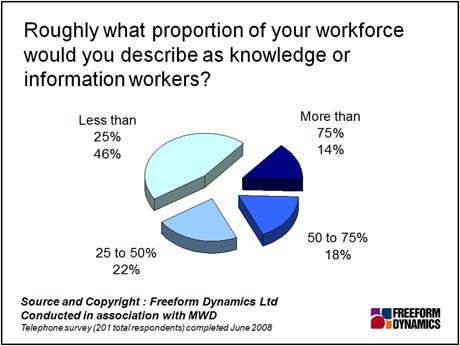Following on from my previous post on the importance of social media enthusiasts breaking out of the echo chamber, I thought I would share a snippet of research from a study we conducted in collaboration with MWD a few months ago.
The reason for doing is because I think something a lot of people overlook is the composition of workforces. Advocates often argue that the real potential of ‘Enterprise 2.0’ is realised by rolling out social media freely across the workforce on a totally inclusive basis and letting people get on with it.
The problem, however, is that most employers rely on a high proportion of the workforce, those whose roles are very process and/or task oriented, just getting on with their job.

In case you are having trouble working out the use of percentages on this chart, what it is telling us is that in almost half of the organisations interviewed (a cross section of larger enterprises), fewer than one in four employees could be categorised as a knowledge or information workers, i.e. the kind of employees for which a case might be made for improved collaboration.
For the remainder of employees, the potential distraction (equivalent to cost in business terms) of providing them with social media facilities is likely to far outweigh any potential benefits.
You can argue with this on idealistic grounds if you like, but if any social media advocate inherited control of a large enterprise and became immediately accountable for productivity, process efficiency, customer service and, ultimately, profitability, would they really be willing to take hit?
So, the takeaway here is to be realistic about the scope of your ambition for social media in a business context and be really quite selective about where you choose to roll it out. And if you do decide to go for it, then approach any initiative objectively. For more thoughts on this, see my article entitled ’Collaboration – get it together’ published a little while back on Silicon.
Through our research and insights, we help bridge the gap between technology buyers and sellers.





Have You Read This?
From Barcode Scanning to Smart Data Capture
Beyond the Barcode: Smart Data Capture
The Evolving Role of Converged Infrastructure in Modern IT
Evaluating the Potential of Hyper-Converged Storage
Kubernetes as an enterprise multi-cloud enabler
A CX perspective on the Contact Centre
Automation of SAP Master Data Management
Tackling the software skills crunch